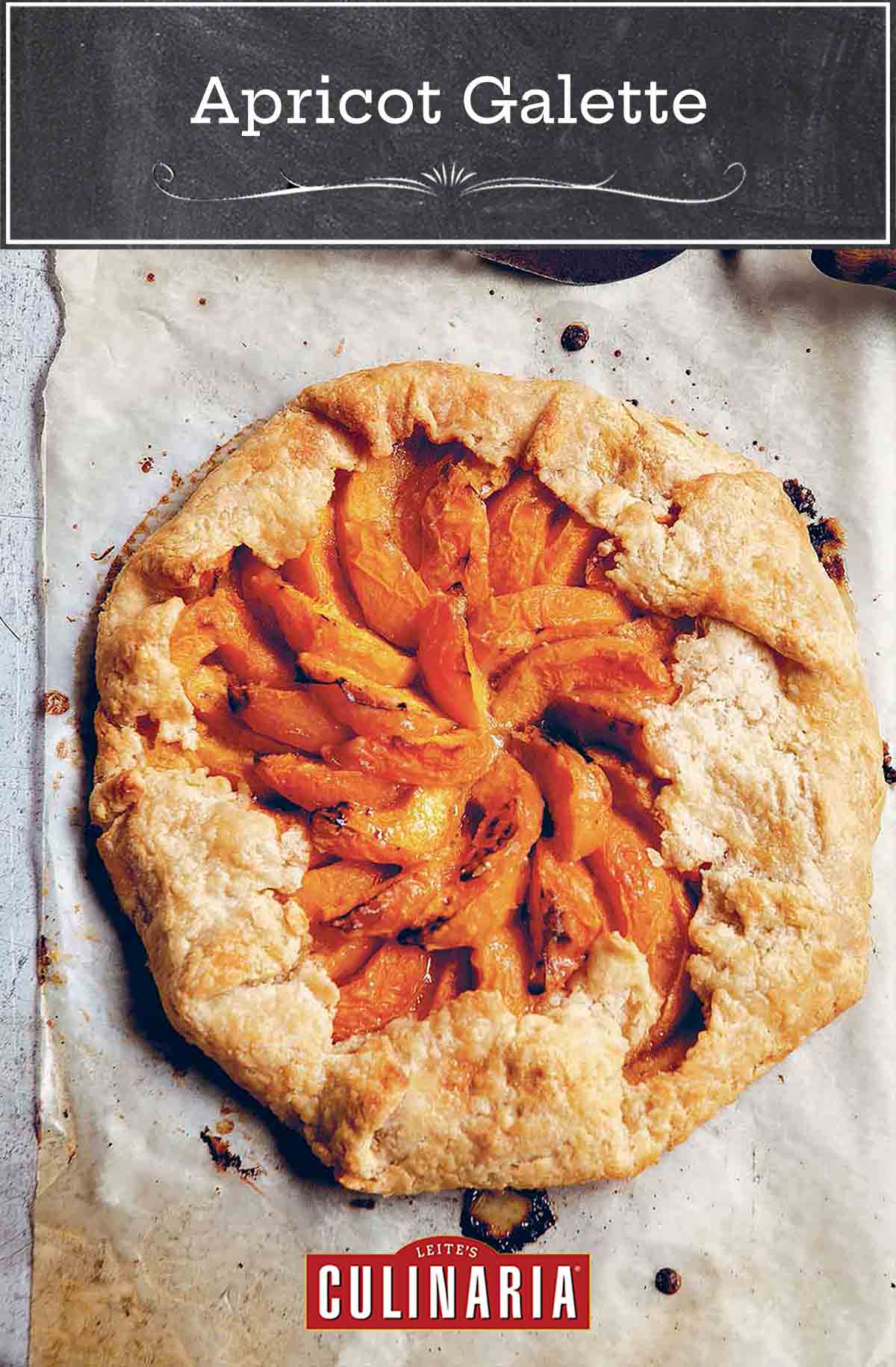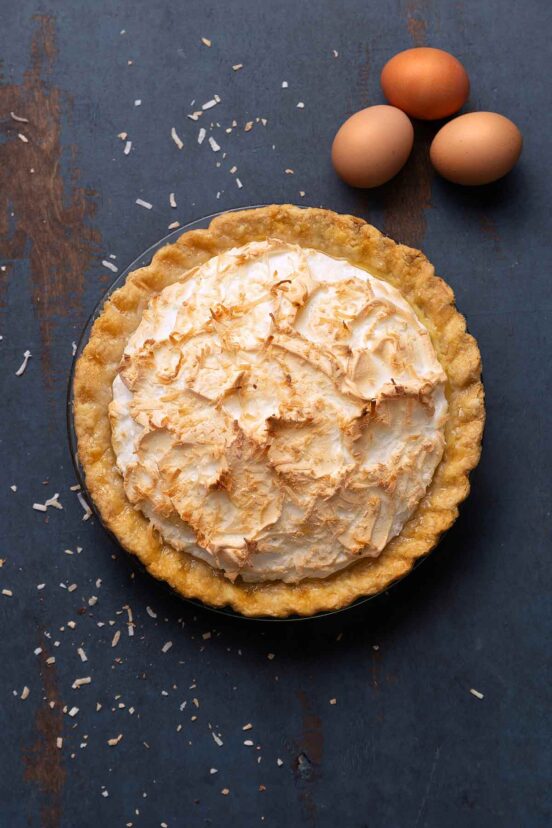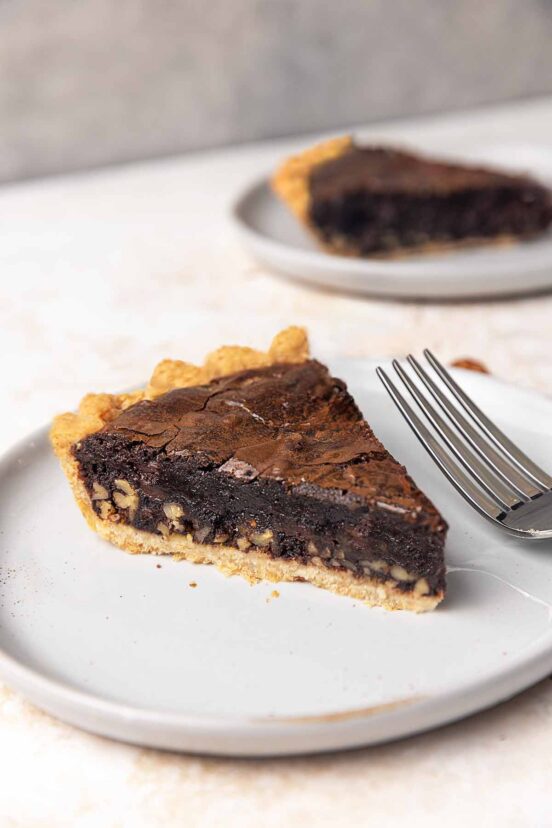
A galette is one of those dishes that is more of a formula than a recipe. Once you learn the basics, you can make a galette with other stone fruits such as peaches, nectarines, plums, or even apples or pears, flavored with a dash of cinnamon.
In the desperate months of winter, we’ve even made this galette with frozen fruit and eaten it as a picnic on the living room floor. It’s great for breakfast the next morning.–Faith Durand
Apricot Galette FAQs
Does pastry that won’t rip or tear or sag or crumble elude you? Are you all thumbs when it comes to the perfect crimp? A galette is a perfect solution–a bottom crust with a pleated, folded edge and no top crust.
From the French, a galette is a simpler, more freeform dessert solution. And because there isn’t a top crust, you’re left with pastry that doesn’t demand perfection, one where an uneven edge or a burnished bump is simply charming. It’s the perfect pie alternative seeing as the galette, by definition, is charmingly imperfect.
Peaches and nectarines make lovely substitutes. Using those will affect the overall flavor as apricots tend to be somewhat tart, while peaches and nectarines are sweeter – but your results will still be delicious.

Apricot Galette
Ingredients
For the crust
- 1 1/2 cups unbleached all-purpose flour
- 1 tablespoon granulated sugar
- 1/2 teaspoon sea salt
- 10 tablespoons (5 oz) cold unsalted butter, cut into 1/4-inch (6-mm) cubes
- 2 to 6 tablespoons ice water
For the apricot filling
- 3 tablespoons granulated sugar, plus more to taste
- 1 tablespoon brown sugar, packed
- 2 tablespoons unbleached all-purpose flour
- 1/8 teaspoon sea salt
- Small pinch freshly grated nutmeg
- 1 1/2 pounds ripe apricots, pitted but unpeeled, cut into eighths
- 1 tablespoon (1/2 oz) unsalted butter, cut into 1/4-inch (6-mm) cubes
- 1 tablespoon heavy cream
- Whipped cream, crème fraîche, or ice cream, for serving
Instructions
Make the crust
- Combine the flour, sugar, and salt in a food processor and pulse a few times to combine. Scatter the butter pieces over the mixture and pulse until the pieces of butter are about the size of peas. (Alternatively, whisk the flour and sugar together in a large bowl and work the butter in with a pastry blender or 2 knives.)
- Sprinkle the ice water over the mixture, 1 tablespoon at a time, and pulse once (or gently toss the mixture with a fork) after each addition. Continue adding water and pulsing (or stirring) until the dough forms small crumbly lumps, like cottage cheese, that clump when you pinch them together. Chances are you won't need all 6 tablespoons of ice water. Be careful not to overprocess the dough. It should not form into a ball while still in the food processor. [Editor's Note: These cautions make the pastry sound really fussy, but we swear, it's not. It's actually easy as can be. And just wait, because the finished crust is so buttery and tender and crunchy you're going to be hooked.]
- Dump the dough out onto a lightly floured work surface and pat it into a 1-inch-thick disk, being careful not to handle it too much. Don't knead the dough. Simply wrap it in plastic wrap and refrigerate for at least 30 minutes. (Or wrap it well in plastic wrap and freeze it for up to 3 months. To use, thaw it in the refrigerator overnight.)
Make the apricot filling
- In a large bowl, combine all but 1 teaspoon granulated sugar, the brown sugar, flour, salt, and nutmeg. Add the apricots and toss until evenly coated. Take a nibble and if your eyes scrunch up and your face puckers, add a touch or a ton more granulated sugar, depending on just how puckery the apricots are. Some apricots are just tarter than others.
To assemble and bake the galette
- Position a rack in the lower third of the oven and preheat the oven to 400°F (204°C). Line a baking sheet with parchment paper and set it aside.
- On a lightly floured surface, roll out the chilled dough to a 14-inch-diameter circle. (If you have trouble rolling the chilled dough, let it rest at room temperature for about 10 minutes, and then try again.) Move the dough to the prepared baking sheet.
- Arrange the apricot filling in the center of the crust, leaving a 2-inch border of dough around the edges. Fold the dough edges over the filling, pinching pleats in the crust as you proceed. Dot the exposed fruit with the cubed butter. Brush the edges of the crust with the cream, and then sprinkle with the remaining 1 teaspoon sugar.
- Bake the galette for 40 minutes, and then lower the oven temperature to 350°F (177°C) and bake for another 10 to 20 minutes, or until the crust is golden brown and the edges are slightly caramelized.
- Remove the baking sheet from the oven and set it on a wire rack for a few minutes to cool slightly. Slip the parchment paper with the galette off the baking sheet and onto the wire rack, and allow the galette to cool. Serve warm or at room temperature with a dollop of whipped cream or crème fraîche or a scoop of ice cream. The galette can be covered with plastic wrap and refrigerated for up to 2 days.
Nutrition
Nutrition information is automatically calculated, so should only be used as an approximation.
Recipe Testers’ Reviews
This apricot galette recipe makes a simple dessert that looks spectacular. The crust on this pie is a keeper—so crunchy, tender, and buttery.
I chilled the dough for 2 hours and needed to let it sit at room temperature for about 10 minutes before I could roll it out. To save a step (and because I’m not very good with pie dough), I rolled it out on the parchment paper and slid that onto the baking sheet. I probably should’ve chilled the crust again before filling it (it was a warm day) because it became sticky and had a couple of tears. I tried to fix them, but my galette still leaked a little in the oven. I baked it at 425°F for 40 minutes and only 10 minutes at 350°F since the crust was brown and the filling was bubbling.
My fresh apricots weren’t perfectly ripe, so the filling could’ve used a couple extra tablespoons sugar, but that’s all forgotten if you serve it with vanilla bean ice cream!
I’ve always wanted to make the perfect pie. Pastry that won’t sag or crumble, fruit that’s not a juicy tower just waiting to collapse, the perfect crimp along the edge. Here’s the solution: the galette. Subtract the crimp, lose the height, leave the seasonal fruit. You’re left with pastry that doesn’t demand perfection, one where an uneven edge or a burnished bump is there simply to be charming. It’s the perfect ruse as it’s perfectly imperfect.
This apricot galette recipe uses a food processor and great directions to make pulling the pastry together a cinch. I used 5 tablespoons ice water to achieve the correct texture. It was a very warm day and though the dough wasn’t sticky, I have no patience for soft pastry. I will fearlessly return misbehaving dough to the fridge at the first sign of sticking. I did this twice during rolling and transferring to the baking sheet to avoid tearing (and swearing!).
The baking time and instructions were just right. We served it at room temperature and had no problems with crumbly pastry or loose, liquidy filling. I did have a problem with the sweetness of the fruit—whoa, were my apricots puckery, almost sour. I wish I’d have doubled the sugar. Whipped cream helped with the tartness. If I’d had the sweetness right, I’d have loved it with crème fraîche. We’ll have the leftovers with homemade vanilla ice cream.
This apricot galette was brilliantly tasty and so easy. It worked the way you so often hope a dessert recipe will. We have lovely Frog Hollow apricots available right now, and this recipe intensified their flavor beautifully. Making the dough with the food processor was a snap, and it’s the flakiest crust I’ve made with the least amount of fuss.
My butter was very cold, as I had just pulled it from the freezer before dicing it, and the dough came together quickly and only needed 4 tablespoons of ice water to yield a moist, crumbly mixture. After chilling the dough, I rolled it out between sheets of parchment paper, so I hardly needed any extra flour. You can have this galette in the oven in 45 minutes then let it rest before serving for dessert.
I was restrained with my nutmeg, which enhanced the flavor of the fruit without overpowering it, so I’d say go lightly. I didn’t have heavy cream, but I did have a fresh carton of buttermilk, so I brushed 1 tablespoon onto the crust after pleating it, which worked beautifully. The top of the galette was nicely caramelized after 40 minutes thanks to the sprinkle of sugar, and I only gave it another 5 minutes in the oven after dropping the temperature to 350℉. By then, the fruit was slightly caramelized on the edges as well. My best taster gave the galette a thumbs-up!
This easily makes 8 servings, and with a ribbon of crème frâiche or a bit of fresh ricotta, it’s the perfect seasonal dessert. I wouldn’t change a thing about this recipe.
To me, apricots signal the start of summer. Their season here is so short, and this recipe is a glorious way to celebrate all that is the apricot. I loved the crust recipe. I haven’t been a fan of making crust in the food processor in the past, but this one yielded a buttery, flaky, and tender crust.
I had to make 2 galettes for a family function, and the entire recipe doubled easily. It only took 6 tablespoons of iced water for double the amount of dough to come together. After 30 minutes in the fridge, the dough rolled out nicely into 2 discs and was most forgiving to work with.
Apricots are easy to slice and de-stone, so 3 pounds were done in about 20 minutes. Assembly was simple once the dough was rolled out onto 2 baking sheets. You can’t beat dumping, folding, pinching, brushing, and popping in the oven. I baked the galettes for 50 minutes, switching the baking sheets after 20 minutes at 400°F and again during the last 10 minutes at 350°F.
The aroma from the oven was heavenly. It was hard to wait while the galettes cooled enough to eat. We served them with dishes of both crème fraîche and whipped cream, and while most people automatically reached for the whipped cream, I preferred the slight tanginess of the crème fraîche.
The apricot galettes themselves were tender, juicy, and nicely caramelized on top. The apricots were slightly tart but didn’t need any additional sugar in my opinion. One taster disagreed and found the fruit a little too tart. I
don’t know how the galette keeps overnight, as there was none left over—always a sign of a good recipe! This is a great recipe to have in your back pocket for when you want to showcase a fruit. Definitely worth making again and again and again.
The dough was very easy to make and came together quickly. I’m used to only having dried apricots or in a trail mix of some sort and rarely eat fresh ones, so this galette was a pleasant surprise. I wish the fruit had been a little sweeter. The amount of sugar called for was not enough for me, so if you don’t like your desserts on the tart side, I’d add more sugar.
The crust was durable enough to handle the fruit and its juices without becoming soggy. To serve, I cut the tart into wedges and got 8 generous pieces.

















Great anytime!
Gerold, I completely agree.
This recipe made as was as delicious as it was easy.
I think the key here is to keep the pastry dough chilled. Cutting the frozen butter into 1/4″ squares made it easy to incorporate into the dry ingredients. Unfortunately, I discovered fruit that tastes perfectly sweet before entering the oven will often turn the finished project sour.
I added sweet cherries on top of the apricots and think it not only made the galette look very pretty, but added to its deliciousness.
Thanks, Betty. I’m delighted that you enjoyed it so much and I love the idea of adding the cherries.